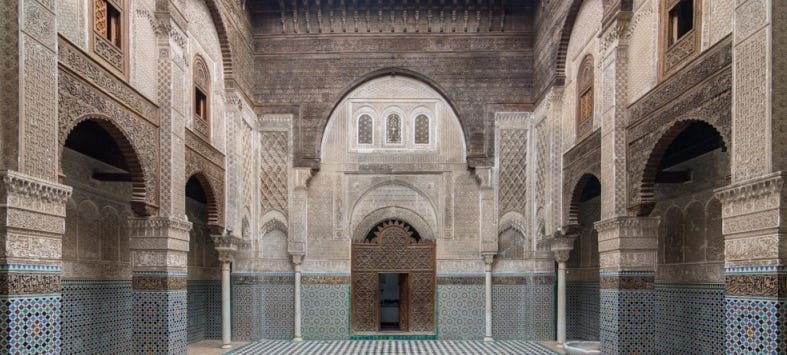Ideas cannot digest reality - Jean-Paul Sartre
Most natural complex systems astound us with their innate order: they exhibit similar patterns at various scales. It is simple rules that generate complexity: natural patterns are described by straightforward mathematical formulas. Fractal self-similarity at different degrees of abstraction surrounds us. The growth of a tree trunk, branches, leaves, and veins are all bounded by similar rules. We see similar patterns of order arising in cities, coastlines, or mammalian circulatory systems. There’s a mathematical order to our everyday life. We need to learn how to leverage it.
Fractal self-similarity in a tree
Innovation arises out of the combination of well-known components in a novel object-oriented fashion. John Holland describes the internal combustion engine as:
“…a new combination of well-established building blocks: gears, wheels, pumps, Volta’s sparking device (sparkplugs), Bernoulli’s perfume sprayer (the carburetor), and so on.”
Through iteration, particular communities of agents at a lower level become the individual agents of the upper levels: the gears and wheels become the car. Most evidently the power of self-similar units is demonstrated by programming: even the most complex computer program can be broken down to bits of 0s and 1s. This is similar to the recursive, object-oriented abstraction of life from atoms, to molecules, organs, the body, social groups, and ultimately cities.
At a high enough level of abstraction, all complex adaptive systems are self-similar: modular, recursive and incremental. The degree of abstraction is lower for hymenopteran insects and higher for cities, but ultimately the terminal unit behavior of each agent of the bee or human system is similar in scope. Whether we’re talking about a bee-hive, a game of Legos, or a human city, the interactions between individual elements give rise to the shape of the physical system. In this sense the simple rules that guide such interactions are crucial in shaping the system as a whole. In similar fashion the repetition of simple elements can give rise to astonishing architecture.
Iteration & repetition of simple elements at the Al Attarine Madrasa in Fes
Communities of agents are at the center of complex adaptive systems. An individual cell might seem minuscule to us, but it can easily be understood as a city in itself: the outer membrane is the urban boundary, inner membranes delimit neighborhoods (organelles); the nucleus is the town hall; mitochondria, the power supply generators; ribosomes, the small workshops producing proteins. Despite it’s size, the activity that happens in each of the 37,200,000,000,000 cells composing one human body, might be more complex than the interactions in one human city.
The Cell represented as a City by Veró Gómez & Patrick Knip
In a certain sense the confusion being sewn by misinformation & the absurdity of the current geopolitical predicament is a product of massive scale and limitless interaction. The interconnectedness and democratization of communication brought by the internet has to a certain degree erased the self-similar hierarchies of abstraction described above: there’s no more local newspapers, or high-quality local entertainment - regardless of our location we refer to the New York Times and watch Netflix. Despite being universally networked we seem to have lost the ability to connect, iterate, and repeat at smaller scales.
Austin, Denver, Amsterdam, Philadelphia, Melbourne - by Eric Fischer
Democracy is failing to cope. Can we envision an object-oriented, community based model of societal organization and decision making? How can cities re-organize, learn and leverage natural patterns of order? Can local communities become the new nucleus of governance? What do you think?
Did you like this issue of thinkthinkthink? Consider sharing it with your network: Share
One Book
The Pattern on the Stone by William Daniel Hillis\ A fantastic book on computers and the logic of programming. Hillis describes in fun and intuitive terms how hardware works and how complex software operations can be broken down to simple, iterative and recursive self-similar components. Beyond being a very good book, The pattern on the stone is also a lesson in how to unpack difficult topics in clear and simple writing.
Three Links
What is complex systems science by Santa Fe Institute\ A fantastic collection of resources, books and foundational papers on complexity.
A Game Designer’s Analysis Of QAnon by Reed Berkowitz\ On the gamification of populism and conspiracy.
To build better cities, planners need to grow out of their masterplans by Joni Baboci\ A short piece I wrote for Apolitical on attempts to change the planning paradigm in Tirana.
Five Tweets
A Neohirasea japonica or togenanafushi, ("thorny stick insect", I don't know if it has an official English name?). About 70mm long and I believe it is a female. Very nice docile creatures. The thorns are mostly for show, its main defense is its clever camouflage. pic.twitter.com/AJ6pPnpshy
— Wrath Of Gnon (@wrathofgnon) November 14, 2020
John Bonner (1920-2019), was professor emeritus at Princeton and studied slime molds for 70 years. Beyond their remarkable ability to “think” and problem-solve, slime molds are just beautiful. This is a selection of molds films captured by young Bonner: https://t.co/yqDd7axDzu pic.twitter.com/Zavd8MDiu2
— Massimo (@Rainmaker1973) November 14, 2020
Fantastic “shoe on the other foot” writing: A Kenyan journalist describes the U.S. election in the language “developed” nations use for African elections.
— Quentin Hardy (@qhardy) November 11, 2020
Brace yourself. https://t.co/ewMT0GmXp1
1/ The city planning of Zootopia, through a Christopher Alexander lens (inspired by @wrathofgnon). First note that the entire city is an island, which naturally creates strong borders and boundaries between the rural/urban area. pic.twitter.com/9zFLbURFEC
— Danny Raede (@DannyRaede) November 11, 2020
Fascinating thread. I had no idea about the long and conflictual history of play streets - shows there’s nothing inevitable about streets being dominated by cars. We can and must reclaim public space for people, and especially kids. https://t.co/UmwfuwVEPd
— Toby Lloyd (@tobylloyd) November 9, 2020
This was the ninth issue of thinkthinkthink - a periodic newsletter by Joni Baboci on cities, science and complexity. If you really liked it why not subscribe?




